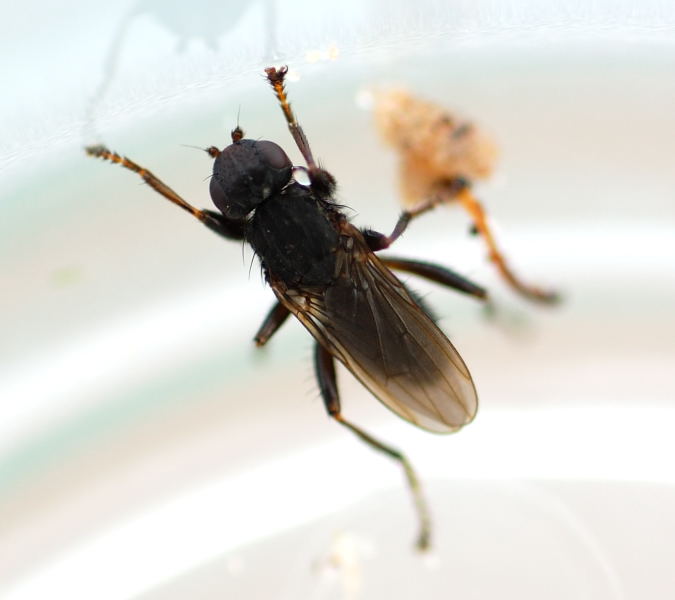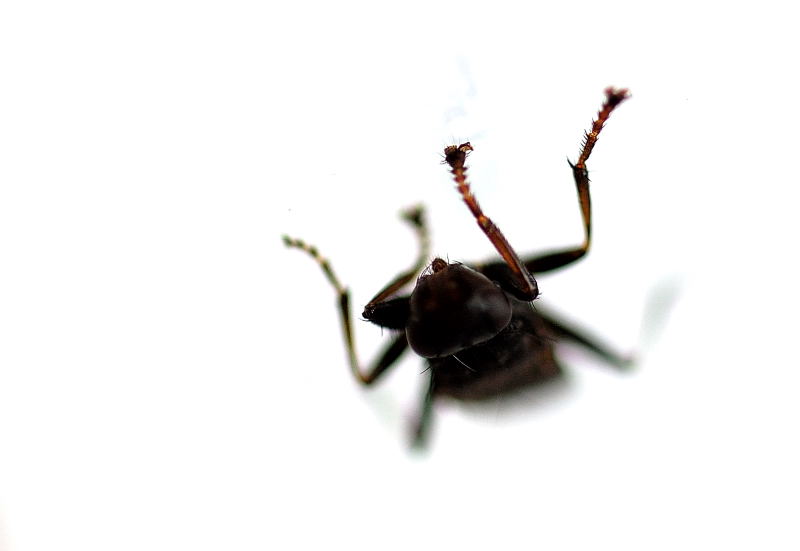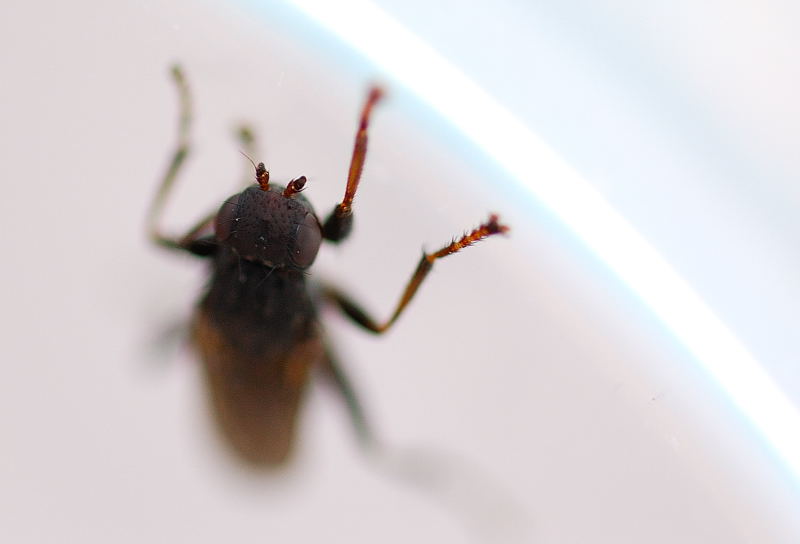Diptera.info :: Identification queries :: Diptera (adults)
Who is here? 1 guest(s)
|
Diptera on beach
|
|
| Amenhotep |
Posted on 08-05-2007 12:30
|
|
Member Location: Glasgow Posts: 14 Joined: 08.05.07 |
Could someone point me into the direction of at least what kind of diptera this is. Location: West Scotland Beach, near Ardrossan. Found in ground under stone with, what I think were collembola, or something that jumped and was white. The fly itself seemed to like to jump too, but I might be mistaken. The location was at the edge of the beach, just where the grass starts. The date was the 07.05.2007. Approximate size 0.5 to 0.7 cm. Amenhotep attached the following image:  [56.53Kb] Edited by Amenhotep on 08-05-2007 12:57 |
|
|
|
| Paul Beuk |
Posted on 08-05-2007 12:49
|
|
Super Administrator Location: Netherlands Posts: 19368 Joined: 11.05.04 |
It gives me the impression of Sphaeroceridae - Copromyzinae, but unfortunately the hind legs are out of focus so it is not possible to check whether the hind metatarsus is swollen or not. Moreover, I am a little baffled by the given size. is it really only 0.5-0.7 mm?
Paul - - - - Paul Beuk on https://diptera.info |
| Amenhotep |
Posted on 08-05-2007 12:56
|
|
Member Location: Glasgow Posts: 14 Joined: 08.05.07 |
Aehm sorry cm, I was so focused on giving all info :\ Sadly since I tried my new macro on extreme apperture I have no hind legs in focus. Thanks for your reply. 
Amenhotep attached the following image:  [42.09Kb] |
|
|
|
| Paul Beuk |
Posted on 08-05-2007 13:03
|
|
Super Administrator Location: Netherlands Posts: 19368 Joined: 11.05.04 |
Well, the spine on the mid tibia rules out some species, but other details I would need are not visible. If you still have the specimen, you could send it fot ID.
Paul - - - - Paul Beuk on https://diptera.info |
| Amenhotep |
Posted on 08-05-2007 13:08
|
|
Member Location: Glasgow Posts: 14 Joined: 08.05.07 |
Thanks that was a great help. I released the fly back into its habitat. I was trying to go more for the artistic angle. This is the last photo I have. I try to get some better shots with a higher aperture too next time. Thanks so much anyway,
Amenhotep attached the following image:  [45.48Kb] |
|
|
|
| Paul Beuk |
Posted on 08-05-2007 13:18
|
|
Super Administrator Location: Netherlands Posts: 19368 Joined: 11.05.04 |
Well, even the artist may appreciate to have a full name to his subject. In that case it is always best to save the specimen, just in case. And don't worry, collecting the single specimen will not lead to its extinction but eventually even may increase our knowledge of it.
Paul - - - - Paul Beuk on https://diptera.info |
| Kahis |
Posted on 08-05-2007 13:19
|
|
Member Location: Helsinki, Finland Posts: 1999 Joined: 02.09.04 |
The antenna in quite un-sphaerocerid-like. Coelopidae?
Kahis |
| Paul Beuk |
Posted on 08-05-2007 13:21
|
|
Super Administrator Location: Netherlands Posts: 19368 Joined: 11.05.04 |
Well..., I'd expect Coelopidae to be much more setose... Wing venation probably fits better for Coelopidae, though.
Paul - - - - Paul Beuk on https://diptera.info |
| Amenhotep |
Posted on 08-05-2007 13:27
|
|
Member Location: Glasgow Posts: 14 Joined: 08.05.07 |
Under normal conditions coelopids are found in the wrack zone of temperate seashores where larvae exploit stranded and rotting seaweed. Specimens are sometimes very abundant in this habitat. Coelopa frigida (Fabricius) has been reared in the laboratory and used for genetic studies. http://hbs.bishopmuseum.org/aocat/coelopidae.html This would pretty much fit the habitat. Picture below On attached picture lower right, exactly where the sand hits the grassy rocky zone, i found it. Plenty of rotting seaweed. Amenhotep attached the following image:  [97.03Kb] Edited by Amenhotep on 08-05-2007 13:28 |
|
|
|
| Kahis |
Posted on 08-05-2007 13:36
|
|
Member Location: Helsinki, Finland Posts: 1999 Joined: 02.09.04 |
Well, I'm a bit out of my league, the Baltic sea isn't really saline enough for most of the real coastal species.
Kahis |
| Amenhotep |
Posted on 08-05-2007 13:41
|
|
Member Location: Glasgow Posts: 14 Joined: 08.05.07 |
Well the Sphaeroceridae seem to be also into seaweed. And it definitly looked more like this one http://en.wikipedia.org/wiki/Image:Copromyza.equina.jpg |
|
|
|
| Tony Irwin |
Posted on 14-05-2007 20:47
|
|
Member Location: Norwich, England Posts: 7234 Joined: 19.11.04 |
This is Orygma luctuosum (Sepsidae, but formerly Coelopidae  ) )
Tony ---------- Tony Irwin |
|
|
|
| Kahis |
Posted on 14-05-2007 21:14
|
|
Member Location: Helsinki, Finland Posts: 1999 Joined: 02.09.04 |
Okay, I was partially right - it is one of the species that don't like our sissy 1% salinity  Or perhaps it's the fact that the Baltic freezes yearly at least along the shores. Or perhaps it's the fact that the Baltic freezes yearly at least along the shores.
Kahis |
| Tony Irwin |
Posted on 14-05-2007 23:23
|
|
Member Location: Norwich, England Posts: 7234 Joined: 19.11.04 |
Amenhotep - Would you consider submitting the first picture for the gallery? It would be a useful addition, since Orygma is so un-sepsid like.
Tony ---------- Tony Irwin |
|
|
|
| jorgemotalmeida |
Posted on 14-05-2007 23:55
|
|
Member Location: Viseu - PORTUGAL Posts: 9295 Joined: 05.06.06 |
Is this a sepsid fly??? the world turned crazy.  |
| Jump to Forum: |














